I offer this reference guide to Chinese coins with the hope of promoting greater understanding and appreciation these coins but please note THIS IS NOT A LIST OF COINS OFFERED FOR SALE.
Images represent the types and may be larger or smaller than the actual coins.
A TIME OF DISUNITY
After 400 years of stability under the Han Dynasty, China was once again torn apart and would remain in turmoil, ruled by numerous small dynasties, until the Sui established a new unity in AD 589.
Schjoth's dynastic sequences for this period are confusing, offering little understanding of the history of the period. We have found that those provided by Michael Mitchiner (Oriental Coins and their Values, The Ancient & Classical World) establish order out of apparent chaos, so we have based our organization of this page on the information he provides. An understanding of the coins of this period requires a basic understanding of the history, so we have included as full a listing of the dynasties involved, including many that do not appear to have issued coins.
EPOCH OF THE THREE KINGDOMS
The fall of Han resulted in a China divided among three major dynasties: Wei in the north, Wu in the south and Minor Han in the west. The following chart shows the relative relationships between them over time.
| Northern China | Southern China | Western China | |
| Pre-221 | Eastern Han | Eastern Han | Eastern Han |
| AD 221-229 | Wei | Wei / Wu | Minor Han |
| AD 229-265 | Wei | Wu | Minor Han |
| AD 265-280 | Western Chin | Wu | Western Chin |
| after AD 280 | Western Chin | Western Chin | Western Chin |
WEI DYNASTY AD 221 - 265
Ts'ao-ts'ao, adopted son of the chief eunuch of Western Han, gained control of Western Han in AD 192. He ruled through a puppet Han emperor whom, in AD 220, he forced to abdicate in favor of his son Ts'ao-pei, who immediately changed the name of the dynasty to WEI.
EMPERORS OF WEI
| Wen Ti also know as Ts'ao-p'ei |
AD 221-228 |
| Ming Ti | AD 228-241 |
| Fei Ti | AD 241-253 |
| King Ti | AD 253-? |
| Mo Ti | AD ?-265 |
Both of the dynasties that co-existed with Wei appear to have issued only high denomination fiduciary coins (discussed below). Unfortunately no coinage has yet been proven to be associated with the Wei Dynasty, but there are two coins that have a possibility of having been cast by the Wei.

S-208-210, Bronze 5 shu. "WU SHU". 12.0 mm. Average about 0.75 grams. These diminutive coins have high rims which protect the characters, so these are seldom seen worn, but are sometimes softly cast. We have seen a few specimens with an intentional raised bump on the lower edge of the hole.
F $7.50 VF $17.00Dating of these small Wu Shus is uncertain but Schoth (page 15) comments on an old record claiming the Emperor Ming of Wei reverted to the issue of Wu-shus, and these were used down to the Chin dynasty, but in reduced sizes. We know high value fiduciary coinage was already circulating by this time, and a monetary system of fiduciary coins cannot successfully circulate side by side with full-weight coinage, so the Wu-shu referred to were likely these very small issues.
The second coinage that has a possibility of having been cast by the Wei are the "CHIH-PAI WU SHU" (value hundred wu shu) attributed to the Minor Han, with "WEI" on the reverse. This is by no means certain as "WEI" could also stand for the Chien-wei, a district in Szechuan province under control of the Minor Han during this period, although that would make this the only mint-marked coin struck between 200 BC and AD 841.
MINOR HAN DYNASTY
AD 221 - 265
In AD 221, after Ts'ao-ts'ao established the Wei Dynasty by overthrowing the house of Han, one branch of the Han Royal family survived in Liu Pe, who established the Minor Han Dynasty with his capital at Ch'eng-tu in Szechuan province. Forty five years later, Ts'ao-ts'ao's great-grandson competed the overthrow, conquering Minor Han, but in the same year Ssu-ma Yen overthrew Wei in a military coup, establishing the Chin Dynasty.
EMPERORS OF MINOR HAN
| Chao Lieh also know as Liu Pei |
AD 221-222 |
| Hou Chou | AD 222-265 |
Mitchiner (page 694) assigns the 100 Wu Shu (500 shu) coins to Chao Lieh (AD 221-222) and the Value 100 (assumed 100 shu) to Hou Chou (AD 222-265). Schjoth notes that Chao Lieh issued value 100 coins, and says they were issued following a war to capture the town of Ch'eng-tu. Being short of funds to pay his troups he issued the value 100 coins on the advice of Liu Pa, establishing price controls to stem the inflation normally caused by such a fiduciary coinage. What is not certain if is the reference to "value 100 coins" is to the coins actually marked value 100 coin and assumed to be 100 shu, or if it is to those marked value 100 Wu Shu, which clearly are 500 shu.
The 100 Wu Shu type while scarce, are more common than one would expect for a two-year type from a relatively small dynasty. The relative sizes and weights of the two issues are consistent with them being two denominations of 100 shu and 500 shu within one series, and are to standards very similar to similar coins issued by WU dynasty in the south. This suggests that both types may have been first issued by Chao Lieh, but both continued as general coins of the Minor Han after his reign so can only be safely dated to the period of the entire dynasty.
100 WU SHU
(500 SHU)
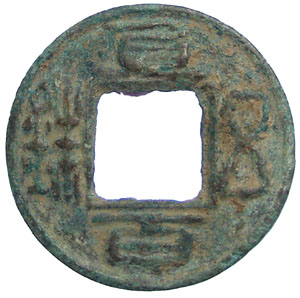
S-181, Bronze 100 Wu Shu (500 shu). "CHIH-PAI WU SHU". Reverse : blank. Average about 26 mm, but vary in weight from about 2 to 8 grams on thick and thin flans.
F $75.00 VF $120.00S-183,Bronze 100 Wu Shu (500 shu), "CHIH-PAI WU SHU" (value hundred wu shu). Reverse : "WEI" on the left side. Average (2 specimens) 7.35 grams (range 6.4 to 8.3), 27.5 mm.
F $95.00 VF $135.00as S-183 but Iron 100, Wu Shu (500 shu), "CHIH-PAI WU SHU" (value hundred wu shu). Reverse : "WEI" on the left side. We have never seen an iron example of this type on the market, so cannot establish a value at this time.
"WEI" may stand for the Chien-wei district in Szechuan province, making this the only Chinese coin cast between 200 BC and AD 841 with a mint mark. "WEI" is also the name of the Minor Han's chief rival dynasty and it may turn out that these coins were actually cast by the Wei.
S-184 variety, Bronze 100 Wu Shu (500 shu), "CHIH-PAI WU SHU" (value hundred wu shu). Reverse : "SHIH" for 10 incuse at the top. The "Shih" appears to be hand cut in and may indicated an attempted re-valuation of this type. The example of this type we have had was 25.4 mm, 3.07 grams, and more nicely cast than the standard ones.
F $85.00 VF $135.00Schjoth mentions two examples, S-185 with and S-184 without "WEI" but with with "SHIH" (10) incuse on the reverse. We have not actually seen one of these, but incuse characters are unusual and most likely mean they were cut in after minting. If so it would suggest these coins were later devalued to 10 shu, consistent with their average weight, but inconsistent with what appears to be the economics of the day and would have to have been done by some later dynasty.
VALUE 100
(assumed 100 SHU)

S-188-190, Bronze 100 shu. "CHIH-PAI" (value hundred). Reverse: blank. Schjoth lists three varieties ranging from 19 to 23 mm, and 1.3 to 2.0 grams, including one without rims, but an example we had recently was 18.0 mm and 1.45 grams. We have seen an example that was only 12 mm, but assume it was probably a contemporary counterfeit. These are similar to the issues of Chao Lieh but smaller, lighter and without Wu Shu in the inscription so it is unclear if the denomination was 100 Wu Shu or 100 Shu, but 100 Wu Shu is more likely.
F $60.00 VF $75.00The experiences of Wang Mang two centuries earlier and several occasions later, demonstrated a fiduciary coinage of this nature could disrupt economies causing hardship for the general population. Normally a situation like this could not continue for long, but all coinage known from this period (from all three dynasties) is of a similar nature and people must have had no choice but to accept them.
S-191, Bronze 50 shu. "Shu-wu" (a backwards Wu-shu). Schjoth mentions that these are considered to be issues of Szechuan.
F $50.00We have handled a few of these, and believe they were an intentional variety. Schjoth indicates they are thought to be coins of the Minor Han Dynasty. As all other coins known to have been cast during the Three Kingdoms Period were high value fiduciary coins, a 50 Shu would fit into the monetary system of the period.
WU DYNASTY
AD 229 - 280
Mitchiner (page694) records that Sun Ch'uan, a general of the Western Han, established himself at Wuchang (Hupai Province) in AD 222 upon the fall of the Western Han. It must have taken him some time to establish a power base as it was not until AD 229 that he took the title of Emperor under the name Ta Huang, establishing the WU dynasty and moving the capital to Nanking. The Wu appear to have been the strongest of the Three Kingdoms, as they survived for 15 years after both Wei and Northern Han had been overrun by the Chin. (Note that Schjoth refers to this as the Eastern Wu Dynasty).
EMPERORS OF WU
| Ta Huang also known as Sun Ch'uan |
AD 222-228 as Sun Chuan AD 229-252 as Ta Huang |
| Sun Liang | AD 252-257 |
| Chao Ti | AD 257-uncertain |
| Yuan Ti | uncertain-AD 265 |
As with the Minor Han, the Wu issued high denomination fiduciary coinage, causing inflation and making counterfeiting very profitable. To combat this, the people were required to hand in their copper possessions in return for the inflated cash coins, thus depriving them of the raw materials of counterfeiting.
Emperor TA HUANG
(Sun Ch'uan)
AD 229 - 259
Reign title: Chia-ho, AD 229 - 237
S-192, Bronze 500 shu. "TA-CH'UAN WU PAI" (Great coin value 500). This type was based on the Ta-ch'uan coinage of Wang Mang, but is of much inferior casting. Schjoth records that these were cast from almost pure copper, which is easily corroded and thus these are often not very well preserved, but we have had specimens that were cast in a brass alloy. The records of Sun Ch'uan (Schjoth page 14) indicate that these coins were first cast in AD 236, the 5th year of Chia-ho.
VF (rough) $115.00Reign title: CHIH-WU, AD 238 - 252

S-196, Bronze 1000 shu. Overse : "TA-CH'UAN TANG-CH'IEN" (Great coin value 1000). Reverse : blank. This type is a continuation of the value 500 type above, with the same casting characteristics. Schjoth (page 14) records these were first cast in AD 238 during the first year of Chih-wu. The weights and sizes of these vary considerably and they tend to be badly cast. The specimen illustrated is 8.75 grams, 34.2 mm (a fairly large example).
F $145.00 VF $250.00Emperor FEI
(Sun Liang)
AD 252 - 257
There is some dispute over the first reign title adopted by Emperor Fei from AD 252-256. Schjoth (page 15) suggests that the title "WU-FENG" was used, but Mitchiner (page 694) states "SUN LIANG" was used. We have not been able to confirm this one way or the other, but in either case, no coins are known for these reign titles and it is likely that the coinage of Chih-su were used.
Reign title: TAI-P'ING. (AD 256 - 257)

S-200, Bronze 100 cash. "TAI-P'ING PAI CH'IEN (value 100), a variety with "TA" written in seal script. Average (3 specimens) 2.55 grams, 24.5 mm
F $75.00 VF $115.00S-204-205, Bronze 100 cash. Obverse: "TAI-P'ING PAI CH'IEN (value 100). Reverse: blank. These are similar to the issue above, but smaller. Average (2 specimens) 17.5 mm, 1.25 grams.
F $45.00 VF $80.00These small issues may have been cast by subject states and rebel states at the end of, or after the fall of the Wu Dynasty. The sizes and weights very considerably and most specimens are poorly cast, often with poorly formed characters.
While reign titles were a well established tradition by this time, Schjoth notes that this is the first use of a reign title on a coin. Some researchers doubt the attribution of this coins to the period, but the inscription means "100 cash of T'ai-p'ing" which clearly indicates the use of a reign title. The style of the coin clearly places it in this general era and there are no other choices to attribute it to.
There is a wide variation in the size, weight and calligraphy style seen on this issue. The smallest examples are about 10 mm and 0.6 grams while the larger ones are 24 mm and 4.3 grams. This suggests that there were many different issues, possibly from a variety of sources over a considerable period of time, including contemporary counterfeits. This also supports the possibility of the Wu issues having been continued after the fall of Wu.
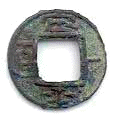
S-206-7, Bronze value 100. "TING-P'ING YI-PAI" (settled peace one hundred). Reverse: blank. There very considerably in size from 12 to 17 mm. The specimen illustrated was 17 mm. 1.1 grams and the last two specimens we had averaged 1.22 grams. Schjoth attributes this type to the Wu dynasty, and, while the general style is correct, we cannot confirm this at this time.
F $40.00 VF $65.00The edges of this type tend to be well finished and fairly square, but the the characters tends to by slightly weakly cast.
It appears that large value fiduciary coins were cast throughout this dynasty, which must have caused a great hardship on the people and the economy. A similar situation seems to have prevailed in the Minor Han Dynasty as well.
It is unlikely regular Wu Shu were issued during the Period of the Three Kingdoms as the fiduciary issues well known from this period could not have existed side by side with a non-fiduciary coinage.
UNIFICATION OF WESTERN CHIN
AD 265-316
The Western Chin dynasty, with its capital at Loyang, was established by Ssu-ma Yen in AD 265 and achieved a new unification of China with the conquest of Wu in AD 280. When Min Ti was killed in an uprising in AD 316 the Western Chin lost control and China was again fragmented into several small dynasties. Emperor Yuan, a member of the Ssu-ma family, retained partial control of the South, establishing the Eastern Chin Dynasty with his capital at Nanking.
EMPERORS OF WESTERN CHIN
| Wen Ti also known as Ts'ao-p'ei |
AD 265-290 |
| Houei Ti | AD 290-307 |
| Houai Ti | AD 307-313 |
| Min Ti | AD 313-316 |
Schjoth (page 14) records that the fiduciary coinage of the Wu dynasty was still in circulation when the Eastern Chin occupied Nanking around AD 317. It is unlikely this could have happened unless they had remained in circulation during the intervening Western Chin Dynasty. Since the coinage of Northern Han was cast to the same fiduciary standard, it likely remained in circulation as well and both coinages may have made up the that used during the Western Chin. No indigenous coinage is known for the Western Chin, and some additional coins must have been needed for a dynasty occupying such a large territory, so that the coin types of Wu and Eastern Chin may have continued to be cast.

S-208-210, "WU SHU". At 12.0 mm, these are very small coins. The high outer rim (but no inner rim) protects the characters, so these are seldom seen worn, but are sometimes softly cast. These were commonly known as "Ch'en Chung". We have seen a few specimens with an intentional raised bump on the lower edge of the hole.
F $7.50 VF $17.00The dating of these small Wu Shus is uncertain. Schoth (page 15) comments on an old record claiming "the Emperor Ming of Wei reverted to the issue of Wu-shus, and these were used down to the Chin dynasty, but in reduced sizes". These could be the reduced-size Wu-shu referred to.
DIVISION OF NORTH AND SOUTH
The unification of Western Chin ended with China divided into a series of Northern and Southern Dynasties. The Southern Dynasties generally followed a direct succession with one dynasty evolving from another via a military coup. Northern Dynasties were less orderly, with succession often by conquest, and at times several dynasties coexisted.
Little is known about the coins from the early and middle years of this period. Reign titles were not used in the south until AD 454 with the "Hsiao-chien" issue of Sung (S-218), or the north until AD 495 with the "T'ai-ho" issue of Northern Wei (S-237).
In reality, no coin can be attributed with certainty to any authority between AD 257 (last year of the Tai P'ing reign title) and AD 454 (first year of the Hsiao-chien reign title), but we can make a few general assumptions about the nature of the coinage. We are fairly certain the monetary systems were still based on high value fiduciary coins in AD 317 (reference Schjoth page 14, a comment under the Wu dynasty), and by AD 430 the monetary systems were based on full-weight coins (reference Schjoth page 16, Sung Dynasty), but we do not know when the transition occurred.
Most dynasties of the Division of Northern and Southern cannot be directly associated with any issue of coins and, especially for the earlier Northern Dynasties, it is possible no coins were cast. For the others, generic Wu shus were probably issued. Modern archeology should one day help sort this out, but the necessary data is not currently available.
THE SOUTHERN DYNASTIES
| AD 316-420 | Eastern Chin | A continuation of the Western Chin |
| AD 420-479 | Sung | Established by a general of the Eastern Chin who usurped power |
| AD 479-502 | Southern Ch'i | Established by a general of the Sung who usurped power |
| AD 502-557 | Liang | Established by a general of the Southern Ch'i who usurped power |
| AD 557-589 | Ch'en | Established by a member of the House of Han after forcing the abdication of the last main ruler of the Liang. Ch'en was conquered by Sui in AD 589. |
The following Southern Dynasties have coins that can be reasonably assumed to have been cast or at least used by them.
EASTERN CHIN DYNASTY
AD 316-420
The Eastern Chin was a weakened continuation of rule by the Ssu-ma family of Western Chin, with their capital now at Chien K'ang near Nanking. Some time after AD 343 a general named Huan Wen usurped power, ruling through K'ang Ti as puppet emperor, but died soon after. The Ssu-ma family regained control until about AD 419 when general Liu Yu killed Emperor Ngan Ti, replacing him with Kong Ti as a puppet emperor. Within one year Kong Ti was in turn killed and Liu Yu declared himself first Emperor of the Sung Dynasty.
EMPERORS OF EASTERN CHIN
| Yuan Ti | AD 316-323 |
| Ming Ti | AD 323-326 |
| Ch'eng Ti | AD 326-343 |
| General Huan Wen through K'ang Ti as puppet Emperor |
AD 343-345 |
| Mu Ti | AD 345-362 |
| Ngai Ti | AD 362-366 |
| Ti Yi | AD 366-371 |
| Kien Wu Ti | AD 371-373 |
| Hiao Wu Ti | AD 373-397 |
| Ngan Ti | AD 397-419 |
| General Liu Yu through Kong Ti as puppet Emperor |
AD 419-420 |
We know of no coins that can be proven to have been cast by the Eastern Chin Dynasty, but Schjoth (page 14) comments When the emperor Yuan of Chin (AD 317-22) crossed the river .... the old currency of the House of Sun was used-light and heavy indiscriminately ....
This refers to the Ta-ch'uan issues of the first Emperor of the Wu Dynasty, but we suspect the "Tai-p'ing" issues of the second Emperor may really be the issues used. We say this because the Ta-ch'uan issues are fairly uniform, which is inconsistent with the reference, while the Tai-p'ing issues show a wide variation in size and weight. This wide variation in size and weight suggests a long period of production which raises the possibility that these coins were still being cast during the early Eastern Chin.
We can also show reason to believe that a regular weight Wu Shu coinage was cast during the later years of Eastern Chin. See below under Sung Dynasty for the explanation.
Schjoth (page 15) claims that Li Shou of Szechuan rebelled against the Eastern Chin, establishing a dynasty called "HAN". We have not been able to find any information of this "HAN" dynasty so list the coins here as Chin Rebel, but suspect that may not be an accurate description. We note the date corresponds with the establishment of the Yen Dynasty in Northeast China, but have not been able to find any relationship there, either.
REBEL LI SHOU OF HAN
AD 337-343
Reign title: HAN-HSING, AD 337-343
In AD 337 Li Shou of Shu adopted the title Han-hsing (Han rising) and changed the name of the dynasty from Eastern Chin to Eastern Han. Their denomination is not certain but if they follow the pattern of similar sized coins in the period that precedes them, they probably circulated as Wu Shu. These are small coins, always softly cast and seldom look any stronger than that illustrated above.
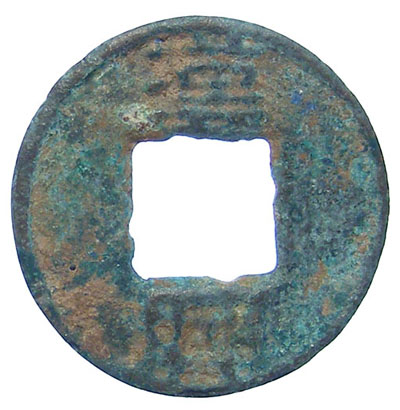
FD-559. Hartill 12.7. "HAN-HSING" (Han rising), similar to S-214 but reads top to bottom. These were probably circulated at the "wu Shu" denomination but this is by no means certain. These are small fairly softly cast coin. Average (1 example) 17.4 mm, 1.13 grams.
F $75.00 VF $115.00S-212 TO 213. Hartill 12.6. "HAN-HSING" (Han rising) reading right to left. These were probably circulated at the "wu Shu" denomination but this is by no means certain. These are small fairly softly cast coin.
VALUE NOT YET DETERMINEDSUNG DYNASTY
AD 420-479
After overthrowing Eastern Chin, Liu Yu took the name Wu Ti as first emperor of the Sung Dynasty. The family of Liu gradually lost power until, in AD 477, general Hsiao Tao Ch'eng killed Emperor Ming Ti, usurping power and placing Chouen Ti on the throne as a puppet emperor but in turn killing him in AD 479 and proclaimed himself first Emperor of the Southern Ch'i dynasty.
EMPERORS OF SUNG
| Wu Ti also known as Liu Yu |
AD 420-423 |
| Chao Ti | AD 423-424 |
| Wen Ti | AD 424-454 |
| Hsiao Wu Ti | AD 454-465 |
| Ch'ien Fei Ti | AD 465-473 |
| Ming Ti | AD 473-477 |
| General Hsiao Tao Ch'eng via puppet Emperor Chouen Ti |
AD 477-479 |
Emperor WEN
AD 424-453
Reign title: YUAN-CHIA (AD 424 - 453)
Schjoth (page 16) records In the 7th year of Yuan-chia (AD 430) a minting department was created for the casting of the Ssu-shu (four shu) coins. The expenses of casting being gratuitous, there was no occasion for illicit casting by the public. This tells us illicit casting was common enough to require measures be taken to stop it, and that it is fairly certain these coins date to this period. (We assume Schjoth based this passage on an ancient record, but he does not reference it.)
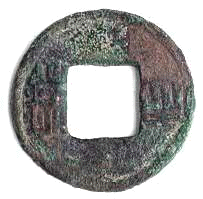
S-215. Obverse: "SSU-SHU" (four shu). Reverse: blank. Well cast coin. Schjoth says that these have with complete rims except for the inner obverse, but the last two specimens we examined did not have an inner rim on the reverse. Average (1 specimen) 23.5 mm, 2.3 grams.
F $115.00 VF $165.00Schjoth's specimens weight 2.68 and 2.96 grams, the standard weight of a Wu-shu and giving an average 0.70 grams per shu, very close to the official weight (as opposed to a coinage weight) of 0.65 grams per shu, established during the Zhou dynasty. From this we conclude they were meant to displace a slightly substandard regular Wu Shu coinage. If cast to replace a fiduciary coinage, a standard Wu- shu would have been good enough.
Since a new minting department had to be established, probably none already existed, so these are probably the earliest coinage of the Sung Dynasty. If the regular Wu-shu in circulation were not cast by Sung, they must have been cast during the later years of the Eastern Chin.
Schjoth (page 16) speaks of a problem of counterfeiting of the Ssu-shu coinage, so it was proposed to cast Wu Shu of eight shu weight. He lists S-217 as being such a coin, but at 3.5 grams and 2.6 mm, it is at the upper range of the weight and size of a regular Wu-shu and far from the 5.2 grams that an eight shu weight requires. Another such coin is listed by Ding Fubao as FD-66, but no weight is given. At this time we cannot confirm any such coins actually exist and have found no evidence that the proposal was even acted upon. Even if such coins had been cast, it is unlikely many would have survived, as one could expect them to be melted down as a source of metal for casting regular weight Wu-shu at a good profit. Further support for this is that there is no doubt that Ssu-shu were cast in the following reign title.
Emperor HSIAO WU
AD 454-464
Reign title: Hsiao-chien (AD 454 - ?)
S-218-220. Bronze 4 shu. Obverse: "HSIAO-CHIEN". Reverse: "SSU-SHU". Even if this issue were cast to a 4 shu coinage weight standard, they should average about 1 gram (the weights very widely). These are very rare and until recently we had never seen a genuine specimen.
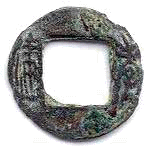
S-221. Bronze 4 su. Obverse:"HSIAO-CHIEN". Reverse: blank. This is the only genuine specimen from this series we have seen. 1.1 grams. 17 mm.
This specimen was a slighty crusty aVF and sold for $400.00Schjoth's three specimens of this issue weighed 1.26, 1.26 and 0.77 grams and include one specimen with the obverse legend reversed and another with "SSU-SHU" missing from the reverse (the specimen we recently had clearly was cast with a blank reverse as well). This tends to suggest that all his specimens were counterfeits, probably of ancient origin. Schjoth himself notes that counterfeiting of this issue was a major problem at the time and that in AD 467 the entire issue was withdrawn from circulation.
Emperor CH'IEN FEI TI
AD 465-473
Reign title: Ching-ho (AD 465, three months only)
S-222. Bronze 4 shu (?). Obverse: "CHING-HO". Reverse: blank. No denomination is implied by this coin,s inscriptions, but the weight of Schjoth's specimen at 2.2 grams is correct for a 4 shu. These coins are very rare, and we have never seen one.
No value can currently be assigned to them.Schjoth (page 16) records that private casting was rampant during Ch'ien Fei Ti's reign and that this issue, and presumably coins of the previous issue, were extensively cast at very low weights. He refers to "YEN-HUAN" coins having been cast to even lower weights, but we have not yet been able to determine what these were.
LIANG DYNASTY
AD 502-557
The Liang Dynasty was established by general Hsiao Yen of the Southern Ch'i Dynasty, but since he was, however distantly, related to the ruling house of the Southern Ch'i, one might think of this as simply a name change of the Southern Ch'i. Using the name Liang Wu Ti, general Hsiao Yen was an able ruler but at his death in AD 549 at the age of 86, there was no able successor and Liang was thrown into anarchy. After a series of ineffective Emperors, Liang was overthrown from within by an official called Ch'uan Pa-Hsien.
EMPERORS OF LIANG
| Liang Wu Ti also known as general Hsiao Yen |
AD 502-549 |
| Kien Wen Ti | AD 549-550 |
| Yu Chang Want | AD 550 |
| Yan Ti | AD 550-? |
| Chen Yang Hou | AD ?-556 |
| Ching Ti | AD 556-557 |
Emperor LIANG WU TI
AD 502-549

S-223. Bronze "WU SHU". Reverse: blank. This is the only Wu-shu variety with a full inner rim on the obverse.
F $22.50 VF $37.50We have not been able to find out why this type is attributed to Liang Wu Ti, but an attribution of this type would normally have been due to an inscribed mould for the type having been found with a dedication to the Emperor.
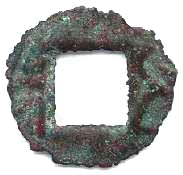
Bronze "WU SHU" cast to look clipped. Reverse: blank. The specimen illustrated is 17 mm, 0.87 grams. Because of the way these were cast, the weights an sizes will probably vary considerable. The specimen illustrated shows clear signs that it was cast this way.
VG $12.50During this, and other periods, it was fairly common for people to clip the edges of coins to recover some metal with which to counterfeit more coins. The result was coins that were missing their rims and sometimes the outer part of their characters. At some point during this period coins were officially cast with the visual appearance of clipped coins. Schjoth attributes these to the reign of Liang Wu Ti, but we are not sure why.
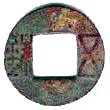
S-225. Bronze "WU SHU". Reverse: blank. Variety cast with no rims and was known as the: Nu-ch'ien" (female cash).
F $22.50 VF $37.50S-227-231. Bronze "WU-SHU" with the left radical of "SHU" missing. Reverse: blank. Schjoth lists the type both with and without rims.
VF $60.00When assigning a coin to either of these issues, one must carefully examine it to be sure it was cast in these forms, and not a regular Wu-shu clipped in antiquity. Some researchers assign these to the Wu Dynasty, but we see little possibility of this being the case. The Wu Dynasty issued fiduciary coins with denominations of 100 to 1000 Shu, and may have cast very small Wu Shus of about 0.75 grams. These are larger 5 shu coins of about 1.5 grams even in their clipped form, and do not fit into the Wu monetary system.
There is another issue (S-226), called "CHIH" or "immature" with the legend cramped into a narrower than usual space between the outer rim and the central opening, that is attributed by Schjoth to the Liang Dynasty and by Mitchiner (#5473-74) to the Ch'en dynasty. With the hundreds Wu-shu varieties as well as slightly substandard old counterfeits with calligraphy and spacing problems, we see little chance such a variation can be assigned to any specific period with a degree of certainty.
Reign title: P'U T'UNG (AD 520-?)
Schjoth (page 17) records The Book of Liang states that in the 4th year of P'u-t'ung (AD 523) the Emperor Wu caused the casting of iron coins.

S-232.Iron "WU SHU". This variety was cast with full rims, and lines radiating from the corners on the reverse.
F $47.50 VF $69.50Schjoth claims these resemble the issues of Emperor Ling of Eastern Han (S-179), but this is not true. The only thing they have is common are the rays on the reverse. The size, style and fabric are completely different. The use of reverse rays is very common during this era, including on the following issue, which Schjoth lists correctly as a coin of the P'u-t'ung period, but creates confusion by placing it under the wrong heading. Another example, from this era, of a coin with rays is S-240 and 241 under the Northern Wei dynasty.
S-234-236. Bronze and Iron Wu-shus. "TA-CHI WU-SHU" (The great good luck wu-shu) all in seal-writing. Reverse: 4 rays extending from the corners of the hole to the rim. Schjoth has two specimens in bronze. One of 25 mm and one of 20 mm but both between 4.25 and 4.75 grams. He had one specimen in iron of 27 mm and 6.16 grams. We have not had one of these and cannot assign a value to them at this time.
Schjoth mentions consideration was given to withdrawing copper coins and issuing only iron but, since iron was far cheaper than copper which would make these fiduciary issues, heavy counterfeiting would have resulted, and the plan was abandoned.
Emperor CHING TI
AD 556-557
Schjoth lists S-233 (Wu-shu with stars at top and bottom) as a probable coin of Ching Ti, but then quotes as his evidence a record of something that happened in the 4th year of T'ai-p'ing (AD 556). Unfortunately, Ching Ti only reigned for one year. We have not found a complete reign title list for the Liang Dynasty, but either Schjoth's reference is totally in error, or T'ai-p'ing was a reign title of either Yan Ti or Liang Wu Ti.
CH'EN DYNASTY
AD 557-589
Ch'en Pa-hsien was a descendant from the House of Han and through him the Han had their last opportunity to rule, controlling much of Southern China. Ch'en remained powerful right up to the end and was the last conquest of the Sui dynasty in their Unification of China.
EMPERORS OF CH'EN
| Ch'en Wu Ti also known as Ch'en Pa Hsien |
AD 557-560 |
| Wen Ti | AD 560-566 |
| Fei Ti | AD 566-569 |
| Hsuan Ti | AD 569-582 |
| Hou Chou | AD 582-589 |
| Ching Ti | AD 556-557 |
Emperor HSUAN TI
AD 557-589
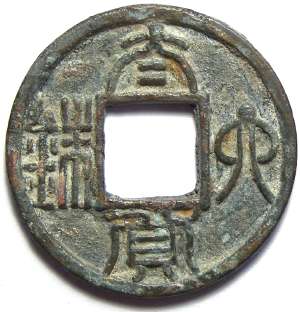
S-243-4, Bronze six shu. "T'AI HUO LIU-SHU" (the six-shu great currency). Reverse: blank. These are very well made coins and normally show up VF or better. Average (2 specimen) 3.39 grams, 25.3 mm.
VF $80.00 XF $120.00As far as we are aware, this is the only time a 6 shu coin was cast. Schjoth had two specimens, one of which weighed 3.21 grams and the other only 1.44 grams. We assume the 1.44 grams specimen was a contemporary counterfeit and have not included it in the average weight above.
According to Schjoth these are very rare, but we have not found that to true.
Schjoth records people were forced to accept these at 10 Wu-shus (50 shu), but later the coins were devalued to 1 Wu Shu (5 shu). This parallels developments occurring in Northern China at the same time under the Northern Ch'i and Northern Zhou Dynasties.
THE NORTHERN DYNASTIES
The Northern Dynasties, largely of non-Chinese ethnic groups, follow a complex pattern with several small overlapping and interrelated Dynasties sometimes occupying the same territory. They can generally be separated in to dynasties of the north east and north west.
DYNASTIES OF THE NORTH WEST
| AD 308-329 | NORTHERN HAN and CHAO |
Northern Han was renamed to Chao in AD 316 and was conquered by Huo Chao in AD 329 |
| AD 307-352 | HUO CHAO | Conquered by the Mongols of the Ch'ien Ch'in Dynasty. |
| AD 351-394 | CH'IEN CH'IN | Mongol Dynasty defeated by the Eastern Chin (a southern dynasty) after which they were taken over by the Hou Ch'in |
| AD 384-407 | HOU CH'IN | We have not found out what happened to this dynasty. |
| AD 397-403 | HOU LIANG | Conquered by the Hou Ch'in |
| AD 397-421 AD 397-414 |
NORTHERN LIANG SOUTHERN LIANG |
Two dynasties set up by generals of the Hou Liang, both of which were conquered by Northern Wei. |
The Dynasties of North western China do not appear to have issued many distinctive coins. We have only found one type attributed to them and even it is doubtful. Standard Wu Shus may have been issued but, as these peoples were mostly local tribes of the northern frontier regions, they may not have had a monetary tradition and some may not have issued coins at all.
HUO CHAO DYNASTY
AD 307-352
Emperor SHIH-LO
AD 307-332
As of yet, we have not been able to find a full account of the events that led Shih-Lo to break away from the Western Chin. Schjoth lists him as a rebel which is probably correct, but since he established a dynasty with at least one successor, he deserves a heading under his own dynasty. Unfortunately, while we know he died in AD 332, and that the dynasty continued to exist until overrun by the Mongols in AD 352, we have not been able to find the names of his successors.
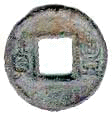
S-211, Bronze, value ?. Obverse: "FENG-HUO" (currency of abundance). Reverse: blank. This type was known as "fu-ch'ien" which means "the cash of riches" and was used as a charm to bring affluence. 25 mm. Average (2 specimens) 2.5 grams. On both of the specimens we have recently had, the character "HUO" is somewhat more complex than that shown by Schjoth on his specimen.
aF $150.0 F $185.00Attributing this type to the Shih-lo dynasty is by no means certain, and the lack of a denomination raises some doubt. Shih-lo ruled parallel with the late Western and early Eastern Chin dynasties when high value fiduciary coins were the norm and denominations were not weight dependent. Only the denomination written on the coin told what it was. This type is likely to have been issued slightly later when Wu-shus were circulating and the denomination could be assumed to be five shu. We do not know exactly when this started, but it could have been as early as the mid-4th century AD, when Shih-lo's successors were still in power, but Schjoth notes these were circulating during the Liang Dynasty (ca AD 500) and it is likely that they were cast closer to that time.
There is a possibility that the specimen illustrated may not be genuine.
DYNASTIES OF THE NORTH EAST
The dynastic situation of Northeastern China was even more complex as a series of Mongol and Turkistan dynasties, often divided internally, formed rival factions.
| AD 337-360 | YEN | The Yen was internally divided and eventually re-organized as the Southern and Northern Yen dynasties in AD 384. |
| AD 384-407 AD 384-398 |
NORTHERN YEN SOUTHERN YEN |
Both of the Yen dynasties were conquered by the Northern Wei. |
| AD 385-535 | NORTHERN WEI | The Northern Wei started out very powerful but became weaker, breaking up internally through military coups. |
| AD 535-550 AD 550-577 |
EASTERN WEI NORTHERN CH'I |
Eastern Wei was set up by a general of the Northern Wei following a military coup. In the second generation the name was changed to Northern Ch'i, but they were quickly conquered by the Northern Zhou. |
| AD 535-557 AD 557-581 |
WESTERN WEI NORTHERN ZHOU |
Western Wei was set up by a general of the Northern Wei following a military coup, and was renamed Northern Zhou in the second generation. In AD 581 the last emperor was forced to abdicate in favor of his uncle, who established the Sui. |
NORTHERN WEI DYNASTY
AD 386-550
The Northern Wei Dynasty was established in AD 386 by a northern Turko-Mongol people known as the Toba (or T'u Pa). They proved very powerful and gradually expanded, conquering several of the surrounding dynasties. In about AD 490, after moving the capital P'ing Ch'eng in Shansi to Loyang in Hunan the Toba began adopting Chinese culture and only after this do we see any coins being issued.
This period also saw Northern Wei power eroded until, in AD 535, two generals succeeded in a coup. In an unusual move they did not declare themselves emperors, but rather established new dynasties as Eastern and Western Wei which they ruled through puppet emperors.
EMPERORS OF NORTHERN WEI
| T'o Pa Kuei | AD 386 - c. 420 |
| T'o Pa Suei | AD c. 420 - c. 422 |
| T'o Pa Tao | AD c. 422 - 452 |
| T'o Pa Sium | AD 452 - c. 466 |
| T'o Pa Hong I | AD c. 466 - 471 |
| T'o Pa Hong II also known as Wen Ti |
AD 471 - 500 |
| T'o Pa Koh also known as Hsuan Wu Ti |
AD 500 - 515 |
| T'o Pa Tze Yu also known as Hsiao Chuang Ti |
AD 515 - 530 |
| Uncertain ruler | AD 530 - 535 |
With the adoption of Chinese culture in about AD 490, the Emperors began adopting Chinese names, thus the use of both Chinese and Toba names for the last three Emperors. We have not been able to find out who was ruling this dynasty during its last five years.
There is evidence suggesting no coins were cast
by the Emperors of Northern Wei prior to AD 495.
Emperor WEN TI
AD 471-499
Reign title: T'AI-HO (AD 476-?)
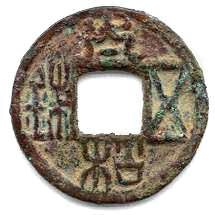
S-237. Bronze 5 shu. Obverse: "T'AI-HO WU-SHU" (The great harmony wu-shu) with T'ai-ho in a slightly angular seal script form. Reverse: blank. These very in size and weight considerably and an average would not mean uch. The three specimens we have handled ranged from 23.8 to 24.6 mm, and from 1.15 to 4.53 grams.
F $175.00 VF $250.00In the 19th year of T'ai-ho (AD 495) it was determined coinage was needed and Wu-shu with the "T'ai-ho" reign title were proposed. With no official government mint until after AD 529 under the next emperor, private minting was officially sanctioned with the provision only pure (adequate??) copper be used. We assume this means the coins were to weigh about 2.5 grams as that was the official standard for a Wu Shu, but it appears that was not always practiced as these vary considerably in both weight and qualty. Schjoth's copper specimen weighed only 1.51 grams and we recently had one of 1.35 grams but we have seen them as heavy as 4.53 grams. Schjoth also lists a specimen in iron (S-238) weighing 7.0 grams.
Emperor HSIAO-CHUANG
AD 528-529
Reign title: YUNG-AN (AD 528 - 529)
The substandard coins resulting from private minting of the "T'AI-HO WU-SHU" must have created economic problems, and in the second year of Yung-an (AD 530) a government mint was established at which the "YUNG-AN WU SHU" were cast.
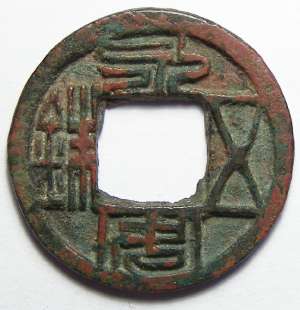
S-239, Bronze 5 shu. Obverse: "YUNG-AN WU SHU" (Wu-shu of eternal tranquillity) with straight arms on "WU". Reverse: blank. Average (9 specimens) 2.29 grams, 22.6 mm.
F $30.00 VF $45.00Schjoth's specimen weighed 3.01 grams, well above the average for the type but we have seen them even heavier with the one illustrate being 3.39 grams (23.2 mm).
S-240, Bronze 5 shu. Obverse: "YUNG-AN WU SHU" (Wu-shu of eternal tranquillity). Reverse: four rays extending from the corners of the inner rim to the outer rim.
VF $95.00Schjoth had two specimens of these, weighing 3.01 grams and 3.57 grams, the average of which is closer to official weight standard of 5 shu, rather than the coinage standard. This would have removed the profit in minting, thus theoretically discouraging private casting however this was tried and failed on previous occasions and probably did here as well, as lighter weight specimens are not unusual. The coins proved popular, and are fairly common today. The large numbers of these that exist, and the lack of any issues attributable to the later emperors of Northern Wei, suggest these became a standard type, issued after the end of this reign title.
NORTHERN CH'I DYNASTY
AD 550-577
The Northern Ch'i Dynasty was founded by Wen Hsuan Ti, the Son of a general who helped overthrow the Northern Wei in AD 535 and the Eastern Wei in AD 550. They existed alongside the Northern Zhou Dynasty, which was established under similar circumstances by a different general, until conquered by them in AD 577.
EMPERORS OF NORTHERN CH'I
| Kao Yang also known as Wen Hsuan Ti |
AD 550-559 |
| Uncertain rulers | AD 560 - 577 |
Emperor WEN HSUAN TI
AD 550-559
Reign title: T'ien-pao (AD 550 - ?)
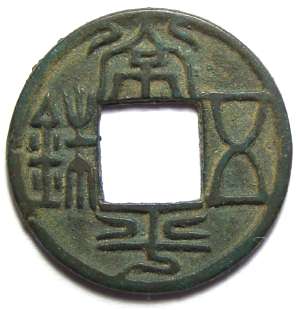
S-242, Bronze 5 shu. Obverse: "CH'ANG PING WU SHU" (Wu-shu of constant equity) in an attractive seal script. Reverse: blank. Average (10 specimens) 25 mm, 3.85 grams.
F $27.50 VF $37.50 VF $95.00The inscription "Ch'ang Ping" is not a reign title, but rather states this is a coin of good value. Probably an attempt to indicate higher weight standard. This type is reported to have been first cast in AD 553.
NORTHERN ZHOU DYNASTY
AD 557-581
The Northern Zhou dynasty was established in AD 557 by the son (whose name we do not yet know) of a general who helped overthrow the Wei dynasty, and then overthrew the Western Wei which he had ruled through puppet emperors. In AD 581 Northern Zhou was renamed as the Sui Dynasty following an internal coup which shifted power between two members of the ruling family. It is interesting that in AD 618 the Sui were in turn overthrown by Li Yuan, a surviving aristocrat of the Western Wei.
EMPERORS OF NORTHERN ZHOU
| Uncertain ruler or rulers | AD 557 - 561 |
| Yu Wen Yung also known as Wu Ti |
AD 561 - 578 |
| Yu Wen Yun also known as Hsuan Ti |
AD 578-580 |
| Yang Chien also first ruler of Sui |
AD 581 |
The coinage of Northern Zhou is fairly simple, with three very distinctive issues from two emperors, all of which are fairly common, however none of them include a denomination and there is therefore a question as to what they were.
Emperor WU TI
AD 561-578
Reign title: PAO-TING (AD 561-572)
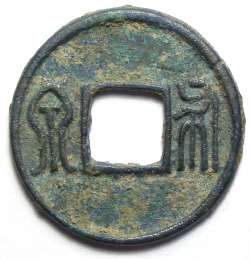
S-245, Bronze value 5 (?). Obverse: "PU CH'UAN". Reverse: blank. Average (4 specimens) 3.8 grams, 26 mm.
VF $39.50Schjoth (page 19) records In the 1st year of Pao-ting (AD 561), the Emperor Wu cast a coinage with the legend Pu-Ch'uan, one "value five" circulating concurrently with Wu-shus. Unfortunately he does not reference the source of this information and it is not clear if "value 5" means this type was to circulate at 5 shu or 5 Wu-shu (25 shu). Since Wu shu were not withdrawn, it likely meant 5 shu. A fiduciary 25 shu is unlikely to have been accepted if regular Wu shu were available.
The inscription is the same as Wang Mang'sPu Ch'uan issues, but the fabric is much coarser. At 3.5 grams, the weight is about the same as the contemporary 6 shu of the Ch'en. Withdrawn in AD 576, only 15 years after first cast, these are seldom found in worn condition.
Reign title: CHIEN-TE (AD 575 - 578)
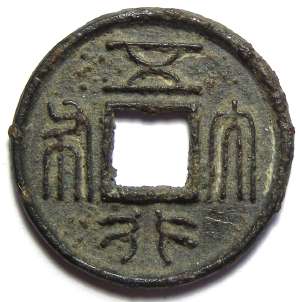
S-246-7, Value 50. Obverse: "WU-HSING TA-PU" (Great currency of the five elements). Reverse: blank. Average (3 specimens) 4.02 grams, 27.9 mm.
VF $60.00 XF $90.00In AD 575 the Wu-hsing Ta-pu were introduced at 1 equal to 10 of the earlier Pu ch'uan, probably making it equal to 50 shu. With an average weight of about 3.7 grams these were fiduciary coins and in order to force people to accept them, the Pu ch'uan (and presumably all Wu shu) were withdrawn in AD 576. Fiduciary coins usually lead to massive counterfeiting and, as lightweight examples of these are sometimes often encountered, it seems this issue was no exception to this.
Emperor HSUAN TI
AD 578-580
Reign title: TA-HSIANG (AD 580)
Withdrawal of the Pu ch'uan's probably created a shortage of coins, and the fiduciary Wu-hsing Ta-pu was probably unpopular, so in AD 580 a new type was introduced, with an inscription suggesting that it would never be withdrawn, thus suggesting the dynasty would last forever.
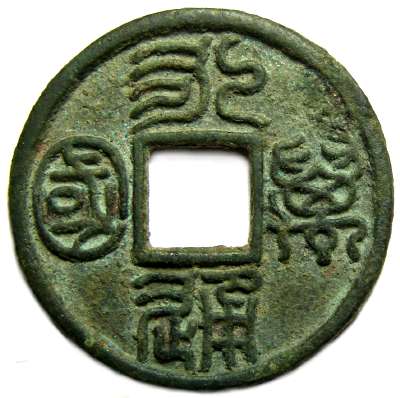
S-250-3. Obverse: "YUNG-T'UNG WAN-KUO" (The everlasting currency of the Empire) in seal script. Reverse: blank. Average (5 specimens) 5.22 grams, 29.6 mm.
VF $110.00 XF $175.00The calligraphy on this issue is, in our opinion, the most attractive on any Chinese cast coin. These are very well-cast coins, and the high rounded rims protect the characters from wear, which is why there are nearly never seen below a grade of VF.
The intended denomination of this issue is not clear. Schjoth (page 19) records these were first cast in AD 580, to a weight of 12 shu (7.8 grams by standard weights or 6.0 grams by coinage weight). He also said they were valued at 10 to 1, but it is unclear if this means they were of value 10 shu, 10 Wu-shu (50 shu) or 10 Wu-hsing ta-pu (100 shu). Specimens we have handled seem to average just over 5 grams, suggesting the intended denomination was most likely 10 Wu-shu (or 50 shu).
Schjoth's three specimens weigh 2.59 grams, 5.2 grams and 10.24 grams. It is reasonable to assume the 2.59 gram specimen, which he says was crudely cast, is an old counterfeit. His middle specimen of 5.2 grams seem about average for the examples we have handled. His 10.25 specimen is far heavier than any we have seen and we are inclined to be suspicious of it as well.
In AD 581 the Northern Zhou Dynasty changed it's name to Sui, and embarked on a path of unification that concluded in AD 589 with the conquest of the Ch'en Dynasty in the South. With this China had entered the medieval age.
Sui, T'ang Dynasties plus the 5 and 10 Kingdomes.
Copyright © 1997 - 2025 R & T Enterprises Ltd.
